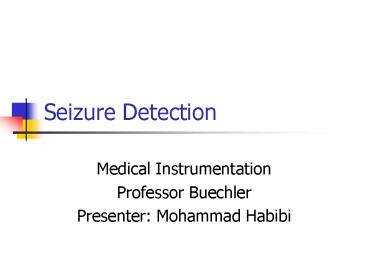Seizure Detection - PowerPoint PPT Presentation
1 / 24
Title: Seizure Detection
1
Seizure Detection
- Medical Instrumentation
- Professor Buechler
- Presenter Mohammad Habibi
2
Outline
- Background
- EEG Signal
- Seizure detection Methods
- Computer simulation
- Conclusion and suggestions
3
Facts About Epilepsy
- At least 2 million Americans and other 40-50
million people worldwide (about 1 of population)
suffer from Epilepsy. - Epilepsy is the second most common brain disorder
(after stroke) - Epileptic seizures occur when a massive group of
neurons in the cerebral cortex suddenly begin to
discharge in a highly organized rhythmic pattern.
4
Epileptic Seizures
- Seizures usually occur spontaneously, in the
absence of external triggers. - Seizures cause temporary disturbances of brain
functions such as motor control, responsiveness
and recall which typically last from seconds to a
few minutes. - Seizures may be followed by a post-ictal period
of confusion or impaired sensorial that can
persist for several hours.
5
Types and Causes
- Partial seizures
- - Simple partial No change in consciousness,
weakness, numbness, unusual smells or tastes.
twisting muscles or limbs, turning the head to
the side, paralysis, visual changes, vertigo - -Complex partial seizures(temporal lobe)
Consciousness is altered, walking in a circle,
sitting and standing, smacking their lips
together, deja vu , uncontrollable laughing,
fear, visual - Generalized seizures involve larger areas of the
brain, often both hemispheres (sides) - -Tonic-clonic (grand mal)
- -Absence (petit mal) Loss of consciousness
- -Myoclonic
6
Causes
- Epilepsy is not associated with any particular
disease - Genetic factors
- Head injury
- Stroke/cerebrovascular disorders
- Metabolic disturbances
- Toxic causes
- Infections
- Tumors and space-occupying
- Degenerative disorders
- Brain damage in infancy
- Febrile seizures
7
Electroencephalogram (EEG)
- is a tool for evaluating the physiological state
of the brain. - offers excellent spatial and temporal resolution
to characterize rapidly changing electrical
activity of brain activation - captures voltage potentials produced by brain
cells while communicating. - In an EEG, electrodes are implanted in deep brain
or placed on the scalp over multiple areas of the
brain to detect and record patterns of electrical
activity and check for abnormalities.
8
EEG signal
- International Standard Electrode placement 10-20
(book) - 5 300 micro volts
- F dc 150 Hz
9
(No Transcript)
10
- T2,F8,T4,T6
11
Seizure Detection Algorithms
- Time domain base
- Frequency domain base
- Time Frequency domain base
12
Seizure Detection Algorithms
- Goytman 1997 - Frequency Spectrum
- Liu 1992 - Autocorrelation function
- Ivon 1998 Wavelet Transform
13
Gotman
- based on the information in the frequency
spectrum - power spectrum differences
- compare with a group of thresholds
- Good result for periodic signals
- Accuracy in this method is based on the
thresholds, nature of seizure, and the electrode
connection
14
Gotman
15
Gotman method for a mix signal
16
Liu (Time domain)
- seizure signal has a periodic property
- autocorrelation function between a seizure signal
and a delayed version of itself, - A non-seizure signal has some irregular peaks.
- A seizure signal contains regularly spaced peaks
of the same frequency as the original signal. - use these peaks to detect rhythmic seizure
activity
17
Liu
18
Wavelet
- The FWT proved superior to the other methods for
seizure detection - Simultaneous time-frequency information with high
resolution. - Resolving high-frequency information in shorter
time and low frequency information for longer
time
19
Example wavelet decomposition ability
20
Digital implementation algorithm
- Step 1 FIR filter ( decomposing signal into
epileptiform, and nonepileptiform) - Step 2 distinguish seizure from single or short
bursts - Find foreground by passing through median filter
- find background by averaging on foreground signal
- Find RKFG-BG
21
Wavelet filter used for simulation
22
Wavelet base
23
Conclusion
- Seizure has many types and shapes
- Detection method based on freq. or time wont
have good specificity and sensitivity - Need to analyze signal in time and freq. domains
at the same time - Neonatal seizure has periodic shape so Liu
algorithm is well suited - Wavelet based has excellent specificity and
sensitivity - What is very important in the seizure area?
24
Appendix (Open Problems)
- Is the seizure occurrence random?
- If not, can seizures be predicted?
- If yes, are there seizure pre-cursors preceding
seizures? - If yes, what measurement can be used to indicate
these pre-cursors? - Does normal brain activity during differ from
abnormal brain activity?































